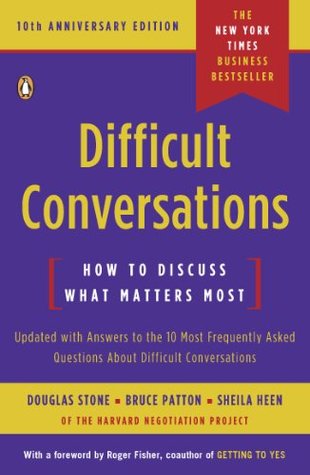More on this book
Community
Kindle Notes & Highlights
Read between
May 13 - May 21, 2020
Divergent views are often rooted in one or more conflicting assumptions or hypotheses. If these can be identified, then you can discuss what would constitute a fair test of which assumption is empirically valid, or to what extent it is valid.
Ask Their Advice. “Help me understand how you would feel and how you might think about the situation, if you were in my shoes. What would you do? Why?
Many difficult situations are amenable to creative solutions that meet most of everyone’s needs, but which may not be obvious and may take some effort to find.
If You Still Can’t Agree, Consider Your Alternatives
Most difficult conversations are not, in actuality, a single conversation. They are a series of exchanges and explorations that happen over time.
That’s how difficult conversations are. They go up and down. You have to keep working at it.
COACH: Right. So he’s making the mistake of assuming he knows what your intentions are when in fact he doesn’t. When we do that in conversations, it creates just what happened here. The other person defends himself, and you get into a pointless argument. JACK: How can I not defend myself? COACH: The best way to handle confusion around impact and intent isn’t to defend yourself. First, you have to acknowledge the other person’s feelings, and only then should you try to clarify what your intentions were.
To make conversations productive, especially in a context of strong emotion, high stakes, and complex perceptions, a critical first step is to distinguish clearly between facts on the one hand, and opinions, assumptions, values, interests, predictions, and judgments on the other.
Moreover, when memory is a factor, the level of uncertainty increases dramatically. Studies show that people are, on the whole, not very reliable witnesses, even when they are paying attention. We often feel certain of memories that are in fact erroneous. We can even transform memories unconsciously, misplacing events in time and location and misremembering who was present, even when the memory itself remains vividly specific.
The bottom line? When you think their view is “just plain wrong,” take a moment to re-examine your assumptions. There’s always a chance that they know something you don’t and there’s no downside to testing your own view and seeking to understand theirs.
The more passionate we are about the issues that matter most to us, the more likely we are to have a cartoonish view of those who see things differently.
be careful about rewarding bad behavior. If you give up and hand people what they want simply “to avoid the hassle,” you end up teaching them that behaving badly pays off, and you will soon see more of the same.
Second, beware of reacting in kind or “playing their game.” Remember that your behavior can affect your reputation far beyond this one interaction. So even if you are being lied to, it will rarely serve you to lie in return and undercut your reputation for integrity.
There are times to give in – when you’re persuaded the other person is right; when the other person cares a lot about the outcome and you care little; when any solution is better than no solution and you need an answer immediately.
Giving in rewards bad behavior, and what gets rewarded gets repeated.
If they are always changing the topic or turning the conversation into an attack on you, work hard to understand their point of view and be open to good faith problem solving. But if they keep making moves that feel like intentional attempts to derail or bully, name the dynamic (there are more examples in Chapter 11), and, if needed, clarify the consequences of no change.
Recognize that aggression can spring from fear.
Patience and persistence pay. Often when someone resists acknowledging their contribution to a situation, it’s because to do so would threaten their identity. In these moments, the other person may need your help in finding a way to frame their contribution that preserves their identity or helps them take a more nuanced view of themselves.
If your real goal in having a conversation is to show your boss he’s wrong, you’re on dangerous ground, and you’re likely to experience all the usual problems with delivering a message from a stance of certainty.
Nothing builds confidence quicker than the knowledge that you can survive the worst that can happen.
Whether you’re a CEO or a parent, we encourage you to make decisions as early and efficiently as possible, to explain those decisions clearly, and to take responsibility for their implementation and effectiveness.
on the flip side, it is not negative feelings in themselves that distract us from productivity, but the failure to acknowledge them, and to deal with them directly, efficiently, and honestly.
The key to managing feelings well is to separate acknowledgment from decision making and to give up the responsibility of fixing them.
Unresolved conflict in our work and personal relationships sucks up energy and attention in sneaky ways that we often don’t take account of.
this behavior is rooted in the belief that a good and valued person doesn’t disappoint people or let them down. He worries that if he does let someone down, he’ll be rejected, or even disowned.
Some of us are physically or emotionally abused by parents, teachers, classmates, or neighbors, and the impacts on identity can run deep. Especially in the case of trauma, there may be physiological changes that inhibit our ability to tell a more empowering or optimistic story about what was going on.
When you finally give up the idea that you have the power to change others, you are giving up something you never had anyway – control.


